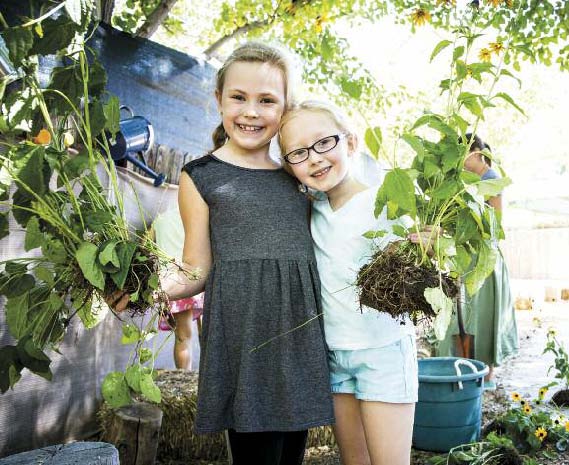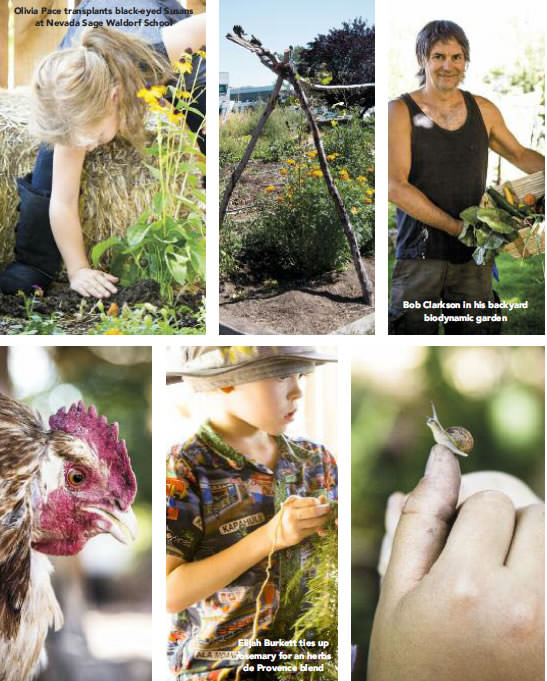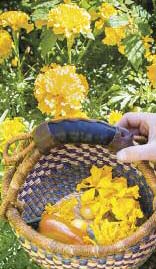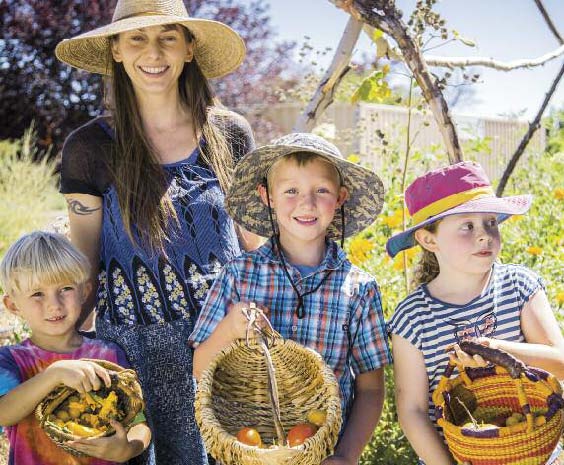edible garden
EARTH’S MEDICINE
Biodynamic practices offer a holistic approach to gardening and more.
WRITTEN BY SUSAN DITZ
PHOTOS BY JEN BRITTON
In a heavy industrial area near the Reno-Tahoe International Airport, a group of children from the Nevada Sage Waldorf School, led by parent volunteer Soma Miller, is doing its part to heal the planet. Together they’ve converted a small, neglected patch of dirt at the edge of a parking lot into a productive teaching garden with healthy, compost-enriched soil that yields a bounty of vegetables and flowers. This outdoor classroom enables K – 5 students to gain valuable life skills while learning lessons in sustainable agriculture.
Nearby, despite winter’s chill, Bob Clarkson and his family of five are harvesting lettuce and other vegetables from a backyard garden just off of Kietzke Lane in Reno. Clarkson, who established the original biodynamic garden at Sage Waldorf, says even in our climate with cold, snowy winters and up to triple-digit hot summers, anyone can be a four-season farmer/gardener by practicing biodynamic techniques. And you can create a farm or garden almost anywhere, as he demonstrated by transforming an old urban driveway into a flourishing row of vegetables.

Biodynamic basics
Developed from the teachings of Austrian philosopher, writer, educator, and social activist Rudolf Steiner (who also founded the Anthroposophical and Waldorf education movements), biodynamics involves a holistic approach to farming, gardening, food, and nutrition. Each farm or garden is viewed as a closed-loop, self-sustaining ecosystem where crops, livestock, compost, and soils are intended to balance and support each other. Like organic producers, biodynamic farmers grow their food without the use of pesticides, herbicides, or genetically modified organisms.
Miller calls it “homeopathic medicine for the earth.”
A student/teacher/advocate for more than a decade, Clarkson says there are several key techniques to successful biodynamic farming.
He explains that one is the use of specific organic preparations considered “healing remedies for the soil.”
Made from fermented manure, minerals, and herbs, these preparations are used in compost and on the soil to help restore and balance the farm’s ecology and improve the nutrition, quality, and flavor of the food being grown.
According to Wali Via from the Biodynamic Association, “[T]he six compost preparations are made from specific herbs: yarrow flowers, chamomile blossoms, the whole areal portion of the stinging nettle while in flower, oak bark, dandelion blossoms, and valerian flowers.”
Some farmers get together seasonally to make these preparations in batches, as it must be done using precise techniques. However, they also may be purchased from certified suppliers such as the Josephine Porter Institute for Applied Bio-Dynamics.

Biodynamic benefits
Clarkson is a local contractor, real estate investor, and father who sees both the economic and environmental benefits of this agricultural method. He’s studied it extensively at Rudolf Steiner College in Fair Oaks, near Sacramento, and is active in the 30-year-old Biodynamic Association of Northern California, based in Nevada City.
He says the other critical process of biodynamics is following a celestial calendar for planting and crop management — recommendations based on cycles of the moon, sun, planets, and stars. He acknowledges that this aspect of the biodynamics practice is a bit “out there” and that the mystical nature can be off-putting to some. Nonetheless, he looks to the cosmos not only for identifying the optimum days for sowing, pruning, and harvesting, but it also guides his decisions about finance and human relationships.
“It works,” he says, smiling.

Though a relatively new agricultural movement in the U.S., biodynamics has been practiced successfully for almost a century across Europe. In the 1980s, it was biodynamic farmers who pioneered the idea of community-supported agriculture, or CSA.
Currently, the U.S. is only in the early stages of consumer recognition of the methods and value of biodynamics, despite an increased public vigilance about how food is produced and brought to market. To be labeled biodynamic, a product must be certified by Demeter USA, the world’s only certifier of biodynamic products. This is a rigorous process, according to Elizabeth Candelario, managing director. The organization acknowledges the challenge of creating understanding of what biodynamics means and is working through retailers to educate consumers, while at the same time building the marketplace in advance of consumer demand.
Biodynamic farming takes organics to the next level and could mean new opportunities for growth in Nevada agriculture, especially for home gardeners and small startup farmers who want to be fully sustainable. Early adopters such as Clarkson have experienced the rewards of being able to raise their own healthy food year round and are eager advocates, willing to share their expertise. Just ask.
Susan Ditz is a Minden freelance writer who was introduced to the benefits of biodynamics when she was farming in Pescadero, Calif.
Resources
Learn more about biodynamic gardening
Bob Clarkson 775-544-2901
Biodynamic Association http://www.Biodynamics.com
Biodynamic Association of Northern California http://www.Bdanc.org
Demeter USA http://www.Demeter-usa.org • http://www.Biodynamicfood.org
Local biodynamic guide
Group members meet each equinox.
A local Biodynamic Gardening Guide meets every equinox and invites all gardening enthusiasts to join them. Topics and locations vary, but in the fall group members met at River School Farm in Reno and prepared Rudolf Steiner’s preparation 500 and discussed biodynamic agriculture.
Preparation 500 is a core element of biodynamics. It involved rhythmically stirring a mixture for one hour. Reportedly, this “medicinally helps the inner life of the soil, and the elemental beings that live in the soil, as the earth’s inward breath creates a potent time during the winter months.”
Each participant is asked to bring a jar or small bucket to take some of the prepared solution home to his or her gardens. It’s recommended that participants treat their gardens within two hours of the gathering.
For details about the group, email Soma Miller at Lotusoma@aol.com.


